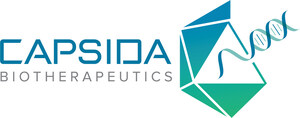THOUSAND OAKS, Calif., Dec. 9, 2021 /PRNewswire/ -- Capsida Biotherapeutics, Inc., an industry-leading gene therapy platform company creating a new class of targeted, non-invasive gene therapies for patients with debilitating and life-threatening genetic disorders, today announced research published in Nature Neuroscience that demonstrated the ability to engineer and select novel capsid variants, with improved enrichment in the brain and decreased liver targeting following intravenous (IV) administration in rodents and non-human primates. The research was led by the laboratory of Viviana Gradinaru, Ph.D., Professor of Neuroscience and Biological Engineering, and Director of the Center for Molecular and Cellular Neuroscience at the Chen Institute for Neuroscience at the California Institute of Technology (Caltech). The publication, entitled, "AAV capsid variants with brain-wide transgene expression and decreased liver targeting after intravenous delivery in mouse and marmoset," was published online today and can be accessed at https://go.nature.com/31I3osS.
Gene therapy is accelerating as a life-saving and life-improving therapeutic option for disorders affecting the brain. For a genetic intervention to be safe and effective, a gene therapy should express a transgene in the affected brain cells while minimizing off-target expression. Adeno-associated viral vectors (AAVs) are powerful options to deliver genetic payloads, but naturally occurring AAV serotypes have limited and overlapping tropisms which represent a significant hurdle to therapeutic development. The research published in Nature Neuroscience describes how combinatorial AAV engineering of multiple loops was utilized to select capsids with brain-wide gene expression and liver detargeting after IV delivery in mouse and marmoset models. To achieve organ-specific targeting after IV delivery, sequential engineering of multiple surface-exposed loops was performed. The work identifies capsid variants that were enriched in the brain by positive selective pressure and targeted away from the liver by negative selective pressure in Cre-transgenic mice. These findings extended to non-human primates following IV administration, allowing for robust, non-invasive gene delivery to the central nervous system (CNS). Importantly, the capsids identified resulted in distinct transgene expression profiles within the brain, with one exhibiting high specificity to neurons.
"The work described in the Nature Neuroscience paper highlights the groundbreaking research from Caltech that provided a roadmap for Capsida's proprietary, non-invasive, targeted gene therapy platform," said Nick Goeden, Ph.D., Chief Technology Officer at Capsida, study first co-author due to his prior research as a Caltech postdoctoral scholar. "We are pursuing several internal programs utilizing IV delivery in humans and expect to file an IND in the second half of 2022."
"The power of this engineering approach demonstrates the ability to create capsids that can target anatomical regions and cell types, while avoiding off-target involvement. The technology opens up the potential for safer and more effective therapeutic possibilities not achievable with traditional AAV gene therapy," added Nicholas Flytzanis, Ph.D., Chief Science Officer at Capsida, and study first co-author from research performed while a scientific director at Caltech. "Many gene therapy companies use surgical approaches to administer CNS medicines, but our engineered non-invasive approach provides the possibility for a broader, more convenient option to treat genetic diseases."
Capsida, co-founded by Flytzanis, Goeden, and Gradinaru, has exclusive license to this technology, which has been further expanded internally into a robust platform by where large-scale, diverse libraries with more than 60 billion capsid sequences each are engineered and screened into primates and disease-relevant human cell lines. Sequence and structure-based analytics are paired with a fully automated engineering platform to quickly prioritize the capsids with the most promising characteristics. Importantly, Capsida's AAV constructs have been studied in hundreds of non-human primates to improve the predictability of these constructs in human clinical trials. Capsida has established collaborations with industry leaders AbbVie and CRISPR Therapeutics to develop next-generation gene therapies for CNS diseases.
About Capsida Biotherapeutics
Capsida Biotherapeutics Inc. is an industry-leading gene therapy platform company creating a new class of targeted, non-invasive gene therapies for patients with debilitating and life-threatening genetic disorders. Capsida's technology allows for the targeted penetration of cells and organs, while limiting collateral impact on non-targeted cells and organs, especially the liver. This technology allows for the delivery of the gene therapy in a non-invasive way through intravenous administration. Capsida's technology is protected by a growing intellectual property portfolio which includes more than 30 patent applications and one issued U.S. patent 11,149,256. The company is exploring using the technology across a broad range of life-threatening genetic disorders. Its initial pipeline consists of multiple neurologic disease programs. The company has strategic collaborations with AbbVie and CRISPR, which provide independent validation of Capsida's technology and capabilities. Capsida is a multi-functional and fully integrated biotechnology company with proprietary adeno-associated virus (AAV) engineering, multi-modality cargo development and optimization, translational biology, process development and state-of-the-art manufacturing, and broad clinical development experience. Capsida's biologically driven, high-throughput AAV engineering and cargo optimization platform originated from groundbreaking research in the laboratory of Viviana Gradinaru, Ph.D., a neuroscience professor at the California Institute of Technology. Visit us at www.capsida.com to learn more.
SOURCE Capsida Biotherapeutics

WANT YOUR COMPANY'S NEWS FEATURED ON PRNEWSWIRE.COM?
Newsrooms &
Influencers
Digital Media
Outlets
Journalists
Opted In





Share this article